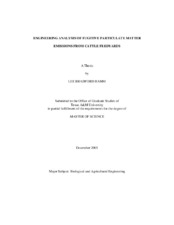| dc.contributor.advisor | Parnell, Calvin B. | |
| dc.creator | Hamm, Lee Bradford | |
| dc.date.accessioned | 2006-04-12T16:05:02Z | |
| dc.date.available | 2006-04-12T16:05:02Z | |
| dc.date.created | 2005-12 | |
| dc.date.issued | 2006-04-12 | |
| dc.identifier.uri | https://hdl.handle.net/1969.1/3240 | |
| dc.description.abstract | An engineering analysis of the fugitive particulate matter emissions from a
feedyard is not simple. The presence of an evening dust peak in concentration
measurements downwind of a feedyard complicates the calculation of an average 24-h
emission flux for the feedyard. The evening dust peak is a recurring event that occurs
during evening hours when particulate matter concentration measurements increase and
decrease dramatically during a short period of time. The concentrations measured during
the evening can be up to 8 times the concentrations measured throughout the rest of the
day. There is a perception that these concentration increases are due to increases in cattle
activity as the temperature decreases during the evening. The purpose of Objective 1 of
this research was to quantify the changes in concentrations based on changes in
meteorological conditions and/or cattle activity. Using ISCST3, a Gaussian-based EPAapproved
dispersion model used to predict concentrations downwind of the feedyard , the
results of this work indicate that up to 80% of the increase in concentrations can be
attributed to changes in meteorological conditions (wind speed, stability class, and
mixing height.)The total fugitive particulate matter emissions on a cattle feedyard are due to two
sources: unpaved roads (vehicle traffic) and pen surfaces (cattle activity). Objective 2 of
this research was to quantify the mass fraction of the concentration measurements that
was due to unpaved road emissions (vehicle traffic). A recent finding by Wanjura et al.
(2004) reported that as much as 80% of the concentrations measured after a rain event
were due to unpaved road emissions. An engineering analysis of the potential of the
unpaved road emissions versus the total feedyard emissions using ISCST3 suggests that it
is possible for 70 to 80% of the concentration measurements to be attributed to unpaved
road emissions.
The purpose of Objective 3 was to demonstrate the science used by ISCST3 to
predict concentrations downwind of an area source. Results from this study indicate that
the ISCST3 model utilizes a form of the Gaussian line source algorithm to predict
concentrations downwind of an area source. | en |
| dc.format.extent | 956314 bytes | en |
| dc.format.medium | electronic | en |
| dc.format.mimetype | application/pdf | |
| dc.language.iso | en_US | |
| dc.publisher | Texas A&M University | |
| dc.subject | cattle | en |
| dc.subject | feedyard | en |
| dc.subject | particulate matter | en |
| dc.subject | ISCST3 | en |
| dc.subject | line source algorithm | en |
| dc.subject | evening dust peak | en |
| dc.title | Engineering analysis of fugitive particulate matter emissions from cattle feedyards | en |
| dc.type | Book | en |
| dc.type | Thesis | en |
| thesis.degree.department | Agricultural Engineering | en |
| thesis.degree.discipline | Biological and Agricutural Engineering | en |
| thesis.degree.grantor | Texas A&M University | en |
| thesis.degree.name | Master of Science | en |
| thesis.degree.level | Masters | en |
| dc.contributor.committeeMember | Lacewell, Ronald D. | |
| dc.contributor.committeeMember | Shaw, Bryan W. | |
| dc.type.genre | Electronic Thesis | en |
| dc.type.material | text | en |
| dc.format.digitalOrigin | born digital | en |


